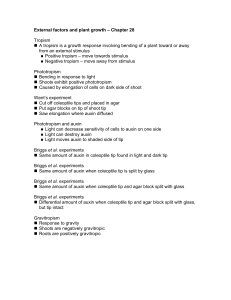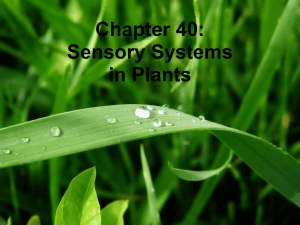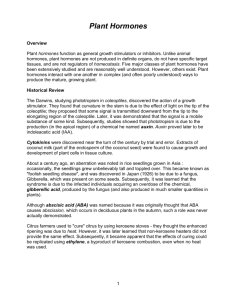Control systems in plants - GeneralBiology-SN
advertisement
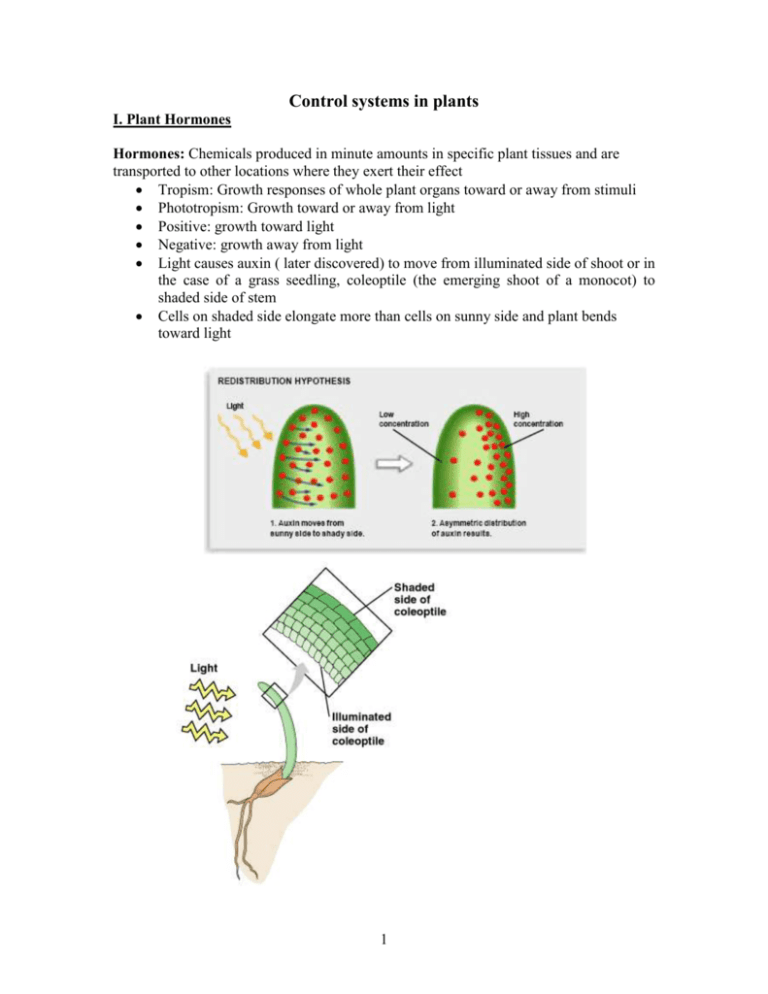
Control systems in plants I. Plant Hormones Hormones: Chemicals produced in minute amounts in specific plant tissues and are transported to other locations where they exert their effect Tropism: Growth responses of whole plant organs toward or away from stimuli Phototropism: Growth toward or away from light Positive: growth toward light Negative: growth away from light Light causes auxin ( later discovered) to move from illuminated side of shoot or in the case of a grass seedling, coleoptile (the emerging shoot of a monocot) to shaded side of stem Cells on shaded side elongate more than cells on sunny side and plant bends toward light 1 Experiments on phototropism led to the discovery of a plant hormone In 1926, F.W. Went removed the coleoptile tip, placed it on an agar block, and then put the agar (without the tip) on decapitated coleoptiles kept in the dark A block centered on the coleoptile caused the stem to grow straight up If the block was placed off-center, the plant curved away from the side with the block. Went concluded the agar block contained a chemical that diffused into it from the coleoptile tip, and that this chemical stimulated growth. Went called this chemical an auxin. Kenneth Thimann later purified and characterized auxin. II. Major classes of plant hormones 1. Auxin Auxin: A hormone that promotes elongation of young developing shoots The natural auxin found in plants is a compound named indoleacetic acid (IAA). The apical meristem is a major site of auxin production. Auxins is transported unidirectionally from apex to base of plant "polar transport" Effects of auxin 2 a. Cell elongation The acid-growth hypothesis states that cell elongation is due to stimulation of a proton pump H+ pumped out lowers pH, activates cellulase enzyme Cellulase enzyme degrades cellulose and loosens the wall, allowing water uptake, which results in elongation of the cell. b. c. d. e. Secondary growth by inducing vascular cambium cell division Promotes formation of adventitious roots Promotes fruit growth in many plants Auxins are used as herbicides. 2,4-D is a synthetic auxin which affects dicots selectively, allowing removal of broadleaf weeds 2. Cytokinin Cytokinins: Derived from the nucleotide Called "cytokinins" because they stimulate cell division (i.e., cytokinesis) Produced mainly in roots; travels through the xylem Effects of cytokinin a. Control morphogenesis (cell division and differentiation) Cytokinins, in conjunction with auxin, control cell division and differentiation. High cytokinin/auxin ratios favor the formation of shoots Low cytokinin/auxin ratios favor the formation of roots. b. Control of apical dominance 3 Cytokinins and auxin contribute to apical dominance through an antagonistic mechanism. Auxin promotes apical dominance by maintaining growth and elongation of stem from the apical meristem and inhibiting axillary bud growth Cytokinins stimulate axillary bud growth c. Cytokinins as anti-aging hormones Cytokinins can retard aging of some plant organs, perhaps by inhibiting protein breakdown and stimulating protein synthesis d. Cytokinins delay the breakdown of chlorophyll in detached leaves by preventing the genes that produce chlorophyll from being turned off 3. Gibberellin In 1930's, Ewiti Kurosawa and colleagues were studying "foolish seedling" disease in rice. Disease caused by fungus called, Gibberella fujikuroi, which was stimulating cell elongation and division. Compound secreted by fungus could cause foolish seedling disease in uninfected plants. Kurosawa named this compound gibberellin. Effects of gibberellin a. Stem elongation Gibberellins are produced primarily in roots and young leaves. Stimulate cell division and elongation in stems, possibly in conjunction with auxin b. Fruit growth Fruit development is controlled by both gibberellins and auxin. The most important commercial application of gibberellins is in the spraying of Thompson seedless grapes. The hormones increase distance between grapes in a cluster to minimize fungi/disease 4 c. Germination The release of gibberellins signals seeds to break dormancy and germinate. In cereal grains, gibberellins stimulate germination and support growth by stimulating synthesis of mRNA coding for α-amylase. The α-amylase then digests the stored nutrients, making them available to the embryo and seedling. 4. Abscisic acid (ABA) Effects of abscisic acid a. Abscisic acid is produced in the terminal bud and helps prepare plants for winter by suspending both primary and secondary growth. b. ABA induces bud and seed dormancy in many plant species and may work in conjunction with other plant hormones (gibberellins) c. ABA also acts as a stress hormone, closing stomata in times of water-stress thus reducing transpirational water loss. 5. Ethylene Ethylene: A gaseous hormone that diffuses through air spaces between plant cells Effects of ethylene a. Stimulates ripening of fruit (used commercially for this purpose) Ethylene triggers the breakdown of cell walls, which soften fruits The signal to ripen spreads from fruit to fruit since ethylene is a gas. b. Abscission Promotes "abscission" dropping of leaves, fruit and flowers from plants at appropriate times of year Mechanics of abscission are controlled by a change in the balance of ethylene and auxin. When auxin levels in the leaf decline, the tissues become sensitive to ethylene that promotes abscission by inducing synthesis of enzymes that digest the polysaccharides in the cell walls, weakening the abscission layer III. Signal-transduction pathways Plant cell responses to hormones and environmental stimuli are mediated by signal-transduction pathways Three steps are involved in each pathway 1. Reception The binding of a hormone to a specific protein receptor in the cell or on its membrane Reception of a hormone only occurs in target cells for that hormone. 5 Target cells possess the specific protein receptor to which the hormone must bind; 2. Transduction Amplification of the stimulus and its conversion into a second messenger Calcium ions appear to be important second messengers in many plant responses. Calcium ions bind to the protein calmodulin, producing calmodulin-calcium complex 3. Induction The pathway step in which the amplified signal induces the cell's specific response to the stimulus. For example, in the signal-transduction pathway of auxin, the second messenger activates a chain of events • Proton pump to acidify cell walls during cell elongation • The golgi apparatus is stimulated to discharge materials to increase thickness of the cell wall • Induction of gene expression that lead to production of proteins required for growth IV . Plant Movements Tropisms: Growth responses of whole plant organs toward or away from stimuli. Three primary stimuli that result in tropisms are light (phototropism ), gravity (gravitropism), and touch (thigmotropism). Gravitropism Gravitropism = Orientation of a plant in response to gravity Roots display positive gravitropism (curve downward). Shoots display negative gravitropism (bend upward). Mechanism of gravitropism in roots: 6 Specialized plastids containing dense starch grains (statoliths) aggregate in the low points of root cap cells. Aggregating statoliths trigger calcium redistribution, which results in lateral transport of auxin in the root. Calcium and auxin accumulate on the lower side of the elongation zone. Roots curve down, because at high concentrations, auxin inhibits root cell elongation, so cells on the upper side elongate faster than those on the lower side. Thigmotropism Growth response to touch Tendrils (garden peas and beans) wind around on object they are using for support Thigmomorphogenesis: Morphological response to chronic mechanical stimulation Plants that are exposed to wind grow shorter and thicker stems. This helps prevent them from being blown down in the wind. V. Turgor movements Turgor movements: Reversible movements caused by changes in turgor pressure of specialized cells 7 Sleep movements Sleep movements: Lowering of leaves to a vertical position in evening and raising of leaves to a horizontal position in morning Occurs in many legumes. Due to daily changes in turgor pressure of motor cells of pulvini (special motor organs located in leaf joints). Cells on one side of the pulvinus are turgid while those on the other side are flaccid. Migration of potassium ions from one side of the pulvinus to the other is the osmotic agent leading to reversible uptake and loss of water by motor cells. VI. Control of Daily and Seasonal Responses 1. Biological clocks and circadian rhythms in plants Biological clocks: internal oscillators that keep accurate time to control many rhythmic phenomena. Plants display sleep movements and a rhythmic pattern of opening and closing stomata. Circadian rhythm: A physiological cycle with a frequency of about 24 hours Most biological clocks are cued to the light-dark cycle resulting from the Earth’s rotation. 2. Photoperiodism Photoperiodism: A physiological response to day length such as seed germination, flowering Photoperiodism Flowering in many plants is induced by length of day and night Shortday: Generally flower in late summer, fall and winter such as poinsettias and potatoes. Long-day plants: Generally flower in late spring and summer such as spinach, radish, clover and corn. Day-neutral plants are unaffected by photoperiod such as tomatoes and rice, Flowering hormone? Most plant physiologists believe an unidentified hormone (florigen or flowering hormone) is produced in the leaves and moves to the buds If all leaves are removed, no photoperiod detection occurs. Phytochromes Phytochrome = A protein containing a chromophore (light-absorbing component) that helps plants to measure the length of darkness in a photoperiod. Phytochrome exists in two interconvertible forms, Pr (inactive form) and Pfr (active form) If the phytochrome is illuminated (sunlight), some Pr is converted to Pfr. Pfr triggers many plant responses to light (e.g., seed germination and flowering). 8 9
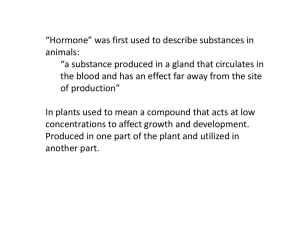
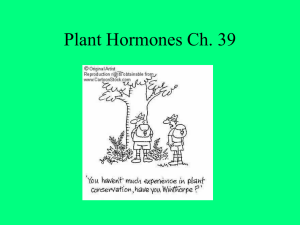
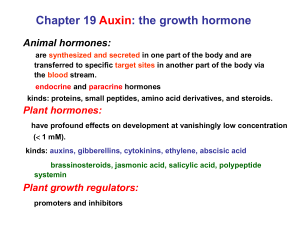
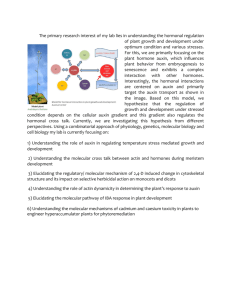
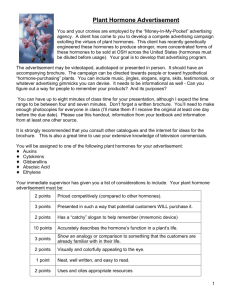
![guide2709.ppt [Compatibility Mode]](http://s3.studylib.net/store/data/008368905_1-88e9b7f8222ebbb87620800faad10ad9-300x300.png)
